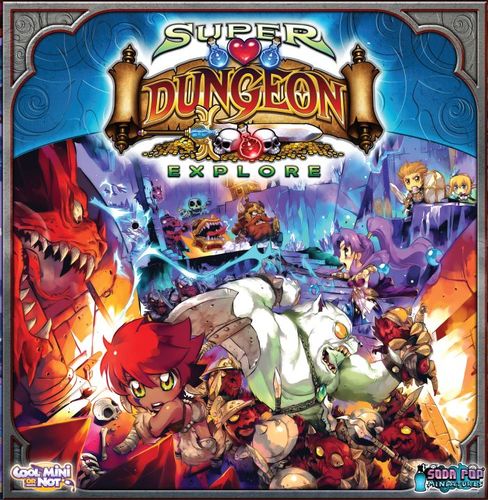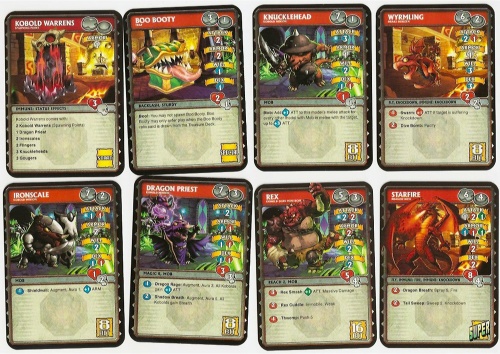Board Game Analysis: Super Dungeon Explore
And now, once again, the deadline informs me it is time to write a board game analysis review thingy. The board game in question this time is Super Dungeon Explore!
Simply the best:
Starting with the best is starting to be a habit of mine, and I see no reason to break that habit anytime soon.
At any rate, the best of Super Dungeon Explore is the build up, and the drama that is brought forth by said build up. For that is something that Super Dungeon Explore does well, because at first our entrepid heroes are living through their wildest power fantasies, taking out multitudes of kobolds and other creepy crawlies, slowly but surely slaughtering their way through the hordes to jab at the spawners with much gusto and bloodshed.
Once enough deaths have occured, the consul then gets the chance to change the mood by bringing out his mini-boss and giving the heroes a proper fight for their money, while they get a little more uncertain as the skull counter ticks towards the spawning of the final boss, the dragon Starfire.
At that point the tables are surely turned as they are now fighting for their very lives, letting both nerves and tempers fly high as every roll of a die now matters more than ever.
While the heroes never survived on our play-throughs, we never felt the dissapointment we suffered at the end of the game like in Battlestar Galactica: The Board Game. Every gruesome end still felt, of not good, then at least not unpleasant. Instead of an flat ‘Oh…’ we got a teeth wrenching ‘Dammit, so close!’, even if it was in fact not very close at all.
All in all, the build up was simply the best of any board game that I have played so far, and it truly enhanced the drama in a good way, at least in this humble writer’s opinion.
The worst:
But it wasn’t all milk, honey and roses in Super Dungeon Quest. The worst part of it was the loot system, which felt disjointed and almost separated from the action, even though it was directly related to it.
The fact that every damaged done by the heroes added a tick on the loot counter, even if no kills were made, felt a bit odd, and it had no relation to what we actually damaged or killed, which further dealt a little damage to our suspension of disbelief. The way it was designed, it just didn’t give us what we felt we wanted, which is all subjective opinions and what not but then again what truly is not, when it comes to reviewing board games.
The Core game system:
Movement, actions, attacks, health, stats, potions, loot cards
The core game system consists of a few different parts, but most are dictated by the special dice that comes with the box.
The game is played out in turns, where either one of the heroes get to move his or her character or the consul gets to activate and move 4 skulls worth of minions, before it’s the turn of one of the heroes to move again.
All in all, when all the heroes have moved and acted, the consul then gets to move the rest of his minions, irregardless of how many skulls they are worth, and then the turn is ended and it all starts over again.
3 are the types of dice that will guide you in your dungeon crawling adventure, the most common and weakest being the blue dice, the more reliable but still chancy red dice and finally the strong and much coveted green dice.
The strengths and weaknesses on the characters and enemies are mainly conveyed through how many dice they get to roll and the colour of said rollable dice.
The stats available to the heroes and enemies on their special cards is attack, which dictates how many coloured dice you get to throw when doing a melêé attack, armour, which dictates how many dice (if any) you get to throw to defend against against an attack (be it melêé , ranged or magic), followed by will, which tells you how many dice you get to throw when attempting to use magic (as well as for rolling for initiative, a pretty important roll which decides whether one of the heroes get to do their turn before some of the monsters), and finally dexterity, which conveys how many dice you get to use on a ranged attack, if your character is capable of doing something like that, that is (n0t to mention a certain character’s special being the option to use her dexterity to dodge attacks instead of relying on armour).
Not only that, the cards also tells you how far you get to move on your turn, as well as how many actions you get to make, for example an enemy costs you one action.
Furthermore there is also health, a very important stat that tells you how many wounds you get to suffer before you die.
Most of the minions have only one health, which further adds to the ‘I am mighty’ power fantasy of the heroes, as they are able to slaughter their way through hordes of them, relising in the massive shedding of blood.
One rather interesting system (but not the most interesting, not even close), is the way heroes get to heal themselves through attacks. Certain dice, well actually only the blue ones, have hearts on some sides, which is in concert with other dice that actually allows the hero to cause a wound, then get to heal either himself or one of his fellow heroes once, or removing a malicious effect, such as poison, fire or even being knocked down.
While a bit odd, it nonetheless somewhat works as a system, and it adds to the drama of the dice rolls, which in this humble opinion is ultimately a good thing.
There is also special actions on each card that you may use instead of attacking normally, such as utilising strange magics or great feats of strength.
Finally there is the potions, the effects of which is unique to each hero. The kicker with potions is that the player is able to quaff them at any given time, giving their usage an extra layer of possible tactical planning, for those who fancy that sort of stuff.
And then there is the two counters, that is slowly ticked up by damage.
One is the beforementioned loot counter, which goes up one tick for each damage the heroes cause to the minions of the consul, and at regular intervals rewards the damaging hero with a loot card, which usually comes in the form of a piece of armour, a weapon or a trinket that gives a small boost in the number of dice that he gets to use in one stat. The loot counter is reset after each turn of the game.
Unrelated but similar is the treasure cards, which the hero gets to draw one of when he opens a treasure chest.
These items are significantly more powerful than those of the loot cards, but then again it is much, much harder to actually get access to said treasure chests, what with the hordes of kobolds, fire creatures and small dragons in the way.
But anyway other is the skull counter, which goes up one tick for each damaged caused, no matter who causes and it affected by it. At regular intervals it goes past a skull (hence its name), which gives the consul another skull point to spend on spawning minions during his next round, which I will go into more detail on below.
The skull counter also decides when the consul gets to spawn his mini boss, and when it reaches the end (or when all spawners are taken out), the big boss is spawned and the fun part truly starts for the consul.
The most interesting:
It is that very spawn system that is nominated as the most interesting system of Super Dungeon Explore.
At the start of each game round, the consul gets to spawn 4 skull points worth of minions near each of his spawners, these minions range from tiny 1 skull kobolds to bigger 2 skull creatures and deadly 3 skull beasts.
And then there is the 4 skulls boss monsters, which the heroes should rightly fear.
As mentioned above he also gets an extra skull to use for spawning for each skull the skull counter has gone past on the previous turn, giving the consul a good chance to recover quite well from a particularly devastating round.
A particularly effective tactic for the consul has proven to be to spawn all his weak swarmers as close to the heroes as possible, and saving his bigger monsters for the spawners further away. That way he gets to earn more skulls for his next round when the swarms are slaughtered, bringing the counter closer to the mini boss and big boss, which he then can back up with his bigger regular monsters and utterly crush the heroes in one fell swoop.
If the dice allows him to, that is.
Target audience:
The target audience given is 11+, which I find to be a suitable age for this game.
It is not a hard game, unlike Battlestar Galactica, nor is it gruesome, at least not gruesome in a gruesome way.
The art style is cutesy, to say the least, and the game play while having the potential to be played in a more advanced way is still accessible for the younger crowd.
The game is quick, easy to get into and I’d say most importantly of all, while naturally highly subjective and purely an unmeasurable matter of opinion, quite enjoyable.
Summary:
All in all, I’d say the craftmanship is of the highest quality, and while it may not menace with spikes of giant cave spider chitin, it is a swell romp and a good way to get people of all ages interested in dungeon crawlers.
Much recommended.

